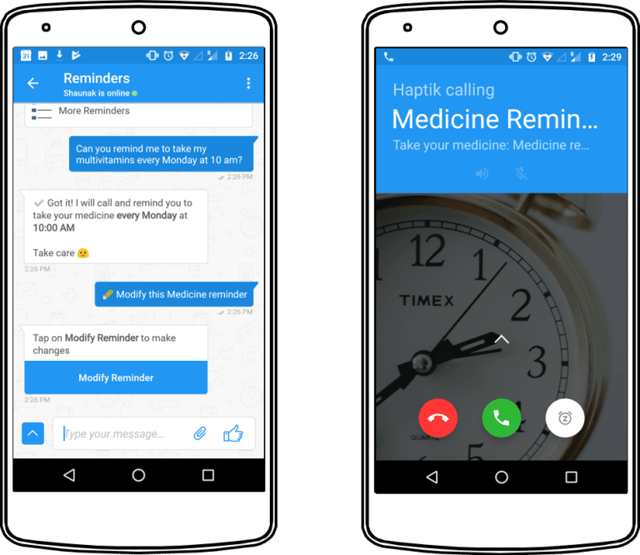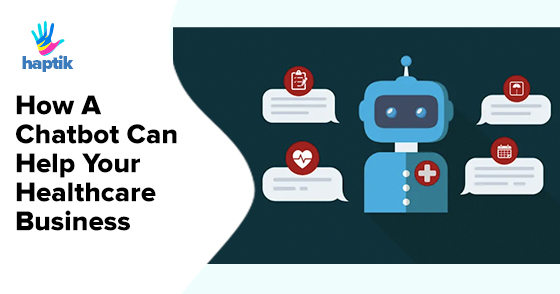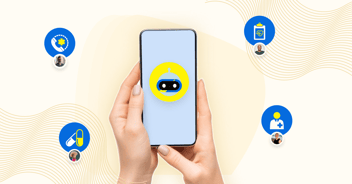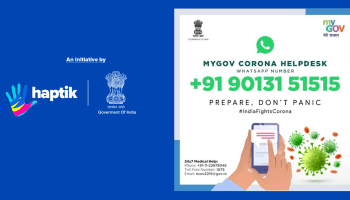Artificial Intelligence and Healthcare might seem like a strange juxtaposition. This is especially true given that good healthcare requires the empathy that only a human medical practitioner can provide.
However, chatbots and health have a history of working well together. Take the example of Judith Newman’s autistic son who found talking to Siri therapeutic as the voice-bot tirelessly and politely answered his queries. Siri even had to turn down a marriage proposal from the boy!
Haptik has been building chatbots for over 4 years which is a decade in today’s fast-growing tech industry. Here’s where we see Conversational AI helping the Healthcare domain in the current and coming years with an accompanying case study to illustrate our claims.
Chatbots for Healthcare can be roughly divided into three categories based on the functionality of the bot. These divisions take the form of a Caregiver, Counsellor and a Clerk respectively. As a bonus, each point also doubles up as a great business lesson that can be learnt from these chatbots!
Be Conversational: The Nurse/Caregiver
We’ve said it before, and we’ll say it again. Chatbots are great for simple, straightforward use cases where the goal is well-defined, and a user’s intent is easily identifiable. Health monitoring falls squarely into this category. During 2008-20, the market is expected to record a CAGR of 16.5 percent.
There are countless apps and smart devices out today that let you monitor and track every aspect of your fitness journey right from your vital stats to how well you’ve been following your diet. Chatbots are a step above these devices as they create a conversational environment where the user is encouraged to talk about their health. Another good use case for chatbots is where a nurse/medical practitioner takes the inputs from multiple sources (like fitness trackers), converts them into actionable insights (increase iron intake, etc.) and recommends suggestions over a chatbot.
Example:
Haptik’s Personal Assistant app offers Medicine Reminders chatbot. A user can simply chat in the Reminders channel and ask the chatbot to remind them about their medicines. The chatbot takes the details of the medicine, the number of times it needs to be taken and the time. The bot then notifies and calls the user to ensure that their medicines are taken. Medicine Reminders are in fact the second most popular reminder type on the Haptik app.
What This Can Do For Your Business:
1. Conversational Element: Chatbots are a great way to engage with users since they add a conversational element to what would normally be a mundane task. Any user is more likely to click on a message that comes from a friend than an advertisement from a brand. Having a messenger or chatbot that sends notifications from your app/website increases app launches by 27% and boosts engagement by 3x. They’re a great way to get your users talking about their health and help them regulate their lifestyle.
2. Gamification is a marketing tactic which motivates your app users to engage with the app to earn rewards. It is a subtle psychological way to motivate users to keep playing and engaging with your app. A survey conducted by TalentLMS showed that 89% of those surveyed stated that a point system on an app would boost their engagement. This is a great way to encourage users to stay on track with their health goals (giving users badges and points for following their diet plan or drinking 8 glasses of water every day) and even suggest improvements to their lifestyle which is also a good way to plug in-app purchases.
| Say goodbye to survey forms by using Conversational AI as your Feedback mechanism. Get our all-new Feedback Bot now 🚀 |
Be a Good Listener: The Therapist/Counsellor
Chatbots make for great listeners. There’s something about being able to talk to a non-human entity that provides a sense of security especially when it comes to mental health and other sensitive topics. The very first psychotherapist chatbot ever created, ELIZA, ran on the simple principle of asking a user to explain what he said before in the conversation.
E.g. User: I don’t feel well.
ELIZA: You say you don’t feel well? Tell me more about that.
Thus, proving that a listening ear is a very powerful palliative to restore mental health.
Example:
Woebot is one such example that has seen major success in this regard.
It is a chatbot-based therapist built by a team of Stanford researchers backed by a strong Cognitive Behavioural Therapy framework. Woebot Labs’ founder and chief executive, Alison Darcy says, “We’re much more on the helpful coaching side. Woebot is an automated guide to a self-guided programme.” The chatbot first creates a profile by asking you basic questions regarding your mental health and energy levels. Once the initial survey is completed, Woebot checks in with the user occasionally to understand their mental makeup. The bot then suggests the necessary steps if it notices any alarming trends.
What This Can Do For Your Business:
1. Engagement: Continuous interaction leads to higher engagement rates which in turn leads to higher retention. And retention is one of the most important statistics to ensure your app’s success in the long run. Woebot has gained traction and now receives two million messages per week, recording a 50 percent month-over-month growth in the last quarter.2. Augmentation and Diagnosis: According to data from WHO, there are just three psychiatrists per million people in India. This is 18 times fewer than the commonwealth norm of 5.6 psychiatrists per 100,000 people. The market is wide open for chatbots to step in as counsellor tools that have no geographical barrier and are always available. They can even help augment a therapist’s work with a diagnosis if the patient requires it.
3. Personalization: Chatbots allow you to showcase your brand’s personality and proactively be accessible to users whenever they need it. This bit of empathy is extremely important in a medical context since every patient’s problems are different and responses must be tailored accordingly.(More about this below)
Be Available: The Secretary/Clerk
Chatbots make for great secretaries and customer service representatives. Why call up a customer care line, listen to a barely understandable IVR system and stay on hold for long minutes? All of this only to ultimately get a scripted response when a chatbot can do the same instantaneously?
As this example of Lal PathLabs (one of the largest Diagnostic chains in India) will attest, chatbots are great at providing instant answers to urgent queries. This works extremely well especially when comes to anxious patients. Thus, proving that availability makes a huge difference to users.
Example:
The Lal PathLabs chatbot (built by Haptik) is a great example of a chatbot being there for your clients 24/7. The chatbot lets users instantly check the status of their pending reports, finds nearby centres, shows test information and price and enables faster query resolution by guiding the user through every step.
What This Can Do For Your Business:
1. Availability: Live chat is slowly becoming a must-have for businesses everywhere and is no longer just a “nice to have” feature. J.D. Power found that a staggering 42% of customers prefer live chat compared to just 23% for email, and 16% for social media or forums. Again, 24/7 availability = calm patient.2. Instantaneity: According to a 2017 Hubspot report, 57% of consumers are interested in chatbots for their instant responses. Especially given the sensitive nature of patients and the urgency associated with a medical test report, an instant response could mean the difference between an anxious, angry patient and a happy one.
3. Simplicity: Most customers don’t have super complicated questions for brands. They usually just want an update or have suggestions regarding their purchases. In fact, we found that most users on the Lal PathLabs chatbot simply wanted to find their Lab ID!
Offloading simple queries like these to the chatbot has even helped reduce the call volume LPL receives on their customer support centre leading to reduced costs for the company. The use case has been so successful that we are now adding appointment booking capabilities to the chatbot as well!
All the above culminate in a great user experience overall and lead to greater conversion rates and generate leads for the healthcare business.
Want to know more about the Lal PathLabs story? Check the case study below to see the results and numbers for yourself!




